Warmer weather is here. It took a while this year, but as it always does, or at least always has done so far, the inconsistent weather of spring has been or will soon be replaced by the warmer weather of early and mid-summer. It’s going to be warm and even hot in the following weeks and months. When we go fishing, if we want to catch some fish, we need to fish in a way that appeals to fish when the weather is warm.
The most basic concept of fishing knows no season. Regardless of when you’re fishing, you’ve got to find the fish. The challenge is this: In the spring, most freshwater fish will be in the shallows where they spawn. Now that the spawn has been completed, they will be where the food is. That could be pretty much anywhere in the water system you’re fishing.
Weedlines are often a good starting point. Several species of fish will hang out along the weedline. You’ll find largemouth bass, walleyes, panfish, and northern pike on the weedline. If two anglers are fishing, it works well to have one angler throw a crankbait and the other a jigworm. This way you’re showing the fish two very different presentations. If the fish are hitting one bait better than the other, both anglers should throw that style of bait.
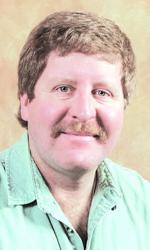
Bob Jensen
Fishing The Midwest
If you employ this technique, the crankbait angler should try a #3XD or #5XD Pro Model crankbait if largemouth are the target or a Lucky Shad if you’re after walleyes. Northern pike will eagerly eat either of these. Also, largemouth will certainly take the Lucky Shad and walleyes will take the XD’s.
The jigworm angler would do well to use an eighth-ounce jighead tipped with a 5- or 6-inch Ocho worm. Use the largest worm they’ll take. This is mostly a largemouth presentation, but a walleye will also readily take this set-up. Go to bigger, bulkier plastics if the fish are hitting good, and go to something smaller like a Ned plastic if the fish are being finicky. If they’re finicky try live bait. Usually they’re not that stubborn. If they’re really shut off, try a lighter jighead, a 1/16th ouncer.
In the summer, along the weedline or on deeper structures, sometimes the fish will be scattered, sometimes they’ll be tightly schooled. You might catch one here and one there, or you might discover that you have to be very precise as to where you put your bait. On the weedline, look for points or pockets in the weeds to hold concentrations of fish. On deeper structures, maybe a rockpile or a corner on a large flat will hold schools of walleyes, bass, or crappies.
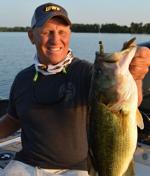
Mike Frisch with a big bass that ate an Ocho worm in mid-summer.
When you’re fishing deeper structure, it pays big dividends to cruise over the structure with a close eye on your sonar. With the sophistication of today’s sonar, you can determine where the fish are before you drop a line. Generally, if you don’t see something that looks like predator fish or baitfish on the sonar, don’t bother fishing the area. Keep looking for an area that has life.
Some anglers feel that spring and fall fishing can be more productive, but summer fish are eating machines. Put the right bait in the right place and you’re probably going to get bit. And for most of us, getting bit is why we go fishing. In the summer you can get bit a lot.
Bob Jensen's fish photos
Largemouth bass

This big largemouth bass ate Mike Frisch’s swim-jig about a week after spawning.
Tiny dancer

On this day, the skies were clear and the fish were finicky. This jumbo perch needed to be convinced to eat by using a tiny jig.
Largemouth bass
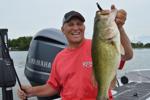
Mike Frisch with a year 2020 lunker largemouth bass. This guy ate a tiny Ned Ocho.
Crappie on Kabetogama

Wade Watson holds a typical fall Kabetogama crappie that ate a Crater jig tipped with a shiner minnow.
Crappie jackpot
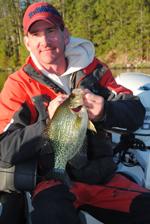
This fall crappie was on the bottom in 22 feet of water when it decided to eat Travis Carlson’s bait.
Fall catch
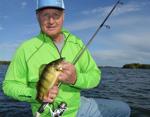
Gary Swenson displays a nice fall perch. A jig/minnow combination took lots of perch, but the jig/Shadpole took the bigger ones on this day.
Fond fish memories
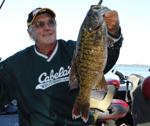
An October memory. Jim McDonnell with a Great Lakes fall smallmouth.
Catfish hunter
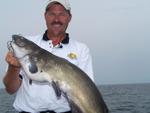
Dean Arnoldussen caught this bonus catfish trolling in early fall.
Crankbait attracts walleye
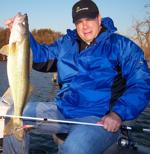
Crankbaits catch walleyes in the fall.
joe honer.jpg
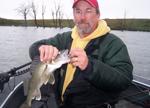
Our fishing friend and outstanding fishing guide Joe Honer with a shallow water fall walleye.
Crappie on the line
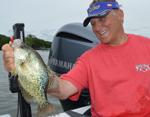
Crappies can be caught right now with jigs in a variety of locations.
Largemouth goes small
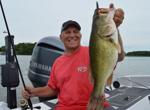
This big largemouth went for a 2.5 inch Ned Ocho. That’s not unusual when the fish are finicky.
Pontoon fishing
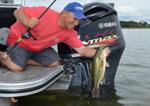
Modern outboards push a pontoon as fast or as slow as an angler or boater might want to go.
Bitten

This mid-summer walleye was taken from a small group of fish that were willing to eat. There was a larger school nearby, but they weren’t biters. Fish the biters.
Mid-summer's dream
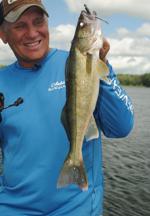
It was midsummer when this walleye ate Mike Frisch’s jig tipped with a plastic tail.
Summer catch
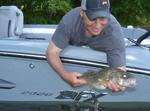
Summer fish can be found almost anywhere. This early summer walleye was in shallow water.
Planer walleye

Here’s Bruce DeShano with a walleye he took on a crankbait behind a planer board in the middle of summer. Note the planer boards in the water at different distances from the boat.
Mid-summer's dream
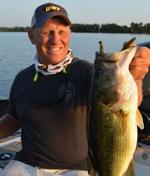
It was mid-summer when this big guy ate an Ocho fished on a jighead. Simple baits catch big fish much of the time.
Creative win
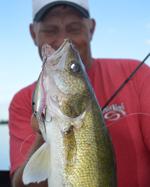
Be creative with your lure presentation and you’ll catch more fish.
Mid-May walleye
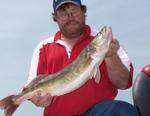
This spawned-out, mid-May walleye liked the looks of Laef Lundbeck’s jig/minnow presentation.
May walleye

Here’s a nice Clear Lake walleye taken in May. On this day, we caught walleyes in the morning and crappies in the afternoon.
Largemouth bass
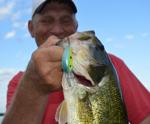
On this summer day, the largemouth bass showed a strong preference for crankbaits in a blue/chartreuse color. Blue/chartreuse is an outstanding color in many waters.
Walleye on opening day
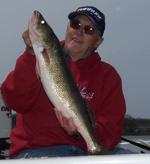
A wonderful memory. The late "Fishing Professor" Jim McDonnell with an Opening Day walleye.
Spring perch
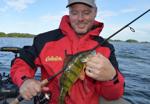
This cold water perch wanted a basic hook/splitshot rig tipped with a minnow and moved slowly along the bottom.
Clear Lake crappie
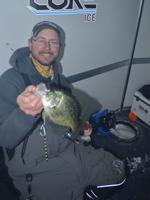
Fishing guide Kevan Paul with a big crappie taken through the ice on a tiny jig.
South Dakota perch
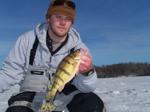
The skies were blue and cloudless and the air temperature was frigid, but this South Dakota perch was willing to eat a tiny jig.
Channel catfish
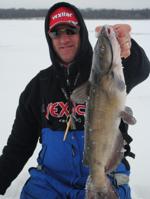
Chris Scholl caught this channel catfish through the ice on Clear Lake in north central Iowa in March a couple of years.
Smallmouth bass in open water
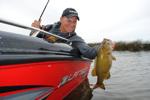
Mike Frisch with an open water smallmouth bass. Now is the perfect time to prepare for open water season by attending sport and boat shows.
Spring walleye
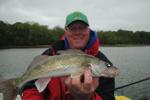
Bill Bunn with an early season walleye that he caught on live bait under a slip-bobber.
Walleye, suspended
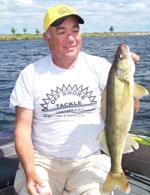
Bruce DeShano caught this Green Bay walleye on a crankbait. The fish was about 15 feet down over 35 feet of water.
To see new and not-so-new episodes of Fishing the Midwest television, fishing articles and new fishing videos, go to fishingthemidwest.com.
April 24, 2021 at 08:00PM
https://ift.tt/3esChoj
Jensen: In summer, you have to go where the fish are - Mason City Globe Gazette
https://ift.tt/35JkYuc
Fish
No comments:
Post a Comment